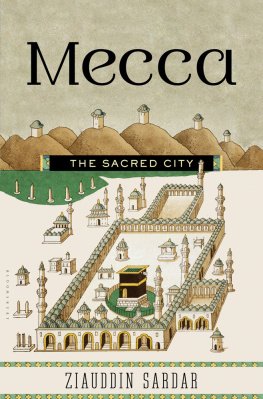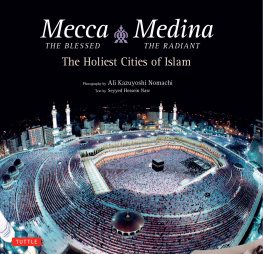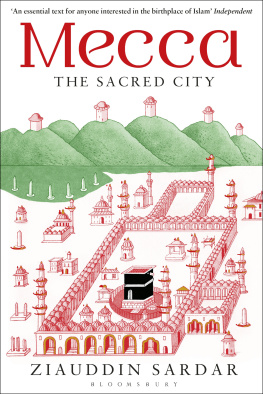THE MECCA UPRISING
THE MECCA UPRISING
An Insiders Account of Salafism and Insurrection in Saudi Arabia
Nasir al-Huzaimi
Edited and translated by David Commins
CONTENTS
It is a pleasure to acknowledge the assistance I have received from friends and colleagues in the course of developing and completing this work. The idea of translating Nasir al-Huzaimis memoir came about during a visit to Riyadh in January 2011, when my good friend from graduate school days, Professor Abdulrahman al-Shamlan, introduced me to Nasir. His memoir offering unique eyewitness testimony of the men behind the 1979 Mecca uprising had just come out and he was interested in having it translated into English. The idea lay dormant until I received a sabbatical leave from Dickinson College in 2015. I very much appreciate Provost Neil Weissman and the Dickinson Faculty Personnel Committee for approving the proposal to dedicate the sabbatical leave to completing a draft translation.
At Dickinson College, I owe special thanks to Magda Siekert for lending her Arabic expertise to untangling some knotty passages; I could always count on Madeline Brown to deliver superb administrative support; Gregory Kaliss and Evan Young provided valuable feedback on annotations; and Steve Weinberger offered suggestions for improving the introduction.
The path to publishing the translation with I.B. Tauris/Bloomsbury began with Joanna Godfreys insight that an introduction setting the memoir in historical context would make it more legible to an English-language readership. The next step was obtaining translation rights from the Arab Network for Research and Publishing in Beirut. I am grateful to Lama Zein for setting that in motion. Three anonymous reviewers offered thorough and perceptive criticisms of the translation that did much to improve it. At I.B. Tauris/Bloomsbury, Sophie Rudland, Olivia Dellow, and Yasmin Garcha gave the manuscript their careful, professional attention and deftly steered it through production.
I owe Professor Shamlan more than I can express for reviewing and editing multiple drafts. The exchange of working drafts would have taken much longer were it not for Najat Bukhari expediting matters for a couple of old friends who never got the hang of the latest technology. From beginning to end, my wife Susan Lindt has been a steady sounding board and loving companion. Finally, I am most grateful that Nasir entrusted me with the translation. I hope that I have done it justice. Responsibility for shortcomings and mistakes in the translation, annotations, and introduction falls on me.
The Arabic edition of Nasir al-Huzaimis memoir, Days with Juhaiman , has five parts: (1) The Memoir; (2) Appendix I: The Dreaming Nation: The Role of the Dream in Sanctifying Salafi Islamic Discourse, by Nasir al-Huzaimi; (3) Appendix II: The Grand Mosque Sermon, Published in al-Riyadh Newspaper, January 17, 1980; (4) Appendix III: Juhaimans Sin: Nasir al-Huzaimi: This Is My Story with the Expected Mahdi, Published in the Electronic Edition of al-Majallah Magazine, November 21, 2009; and (5) Appendix IV: Interview with Nasir al-Huzaimi, by Badr al-Rashid. The English edition contains an additional section about the authors childhood in Iraq.
Part 1 of the Arabic edition, The Memoir, is divided into five sections: (1) Beginnings; (2) In Mecca; (3) In Medina; (4) Return to Riyadh; (5) Millenarian Rule in Juhaimans Thought.
For the English edition, I have divided the Memoir into nine sections and added subsections to guide the reader.
The Arabic edition mentions dozens of classical authors and texts that are moved to endnotes in the English edition. The Arabic edition also includes numerous footnotes indicated as Footnote in al-Huzaimi.
Text in parentheses is part of the Arabic edition. Text in brackets is the translators interpolation.
The English edition rearranges some of the text from pages 16 through 21 in the Arabic edition for the sake of narrative continuity.
What Was the Mecca Uprising?
On the morning of November 20, 1979, a band of around three hundred armed men stunned the world by seizing the Grand Mosque in Mecca, the spiritual axis of Islam. In the Muslim lunar calendar, it was an auspicious date for their action: the first day of a new century. The groups charismatic leader, Juhaiman al-Utaibi, had been preaching that recent events in Saudi Arabiathe rise of corrupt rulers and the spread of foreign influenceaugured the coming of the Muslim savior, called the Mahdi. In the past year, group members had been telling one another about having dreams where they saw the Mahdi in the form of a fellow member. Firmly believing that the Mahdi was among their number, they stormed the Grand Mosque, expecting to partake in apocalyptic events foretold in tales from the Prophet. The millenarians fended off Saudi security forces for two weeks before surrendering. A month later, the Saudi government carried out public beheadings of sixty-three captured insurgents, including Juhaiman.
The Mecca uprising is considered a turning point in Saudi Arabias contemporary history. In the 1960s and 1970s, the kingdom was starting to open up to Western influences, then abruptly reversed course in response to the events of November 1979. The rulers felt the uprising meant they had to reaffirm their commitment to upholding Islam, so they took steps to curtail Western influence, imposing stricter censorship on liberal writers, enforcing puritanical restrictions on womens dress, and cracking down on interactions between unrelated men and women. They also increased funding for religious institutions and gave free rein to conservative voices in the media. At the same time the government promoted an ultraconservative religious climate inside the country it spread its homegrown puritanical doctrine to Muslim societies and Muslim communities in Western countries.
Nasir al-Huzaimis Memoir
Many details about the Mecca uprising and its background remained unknown to the outside world until the early 2000s, when former members of the Salafi
Huzaimi grew up in southern Iraq and moved to Saudi Arabia where he joined the Salafi Group in 1976. For two years, he spent much of his time in Juhaimans company before drifting away from the group in the wake of a government crackdown. He did not participate in the uprising, but he was arrested in a government sweep of Salafi Group members and spent six years in prison. In 2011, he published his memoir, Days with Juhaiman , offering the most detailed picture we have of the Salafi Group and Juhaiman.
Huzaimi takes the reader deep into the puritanical subculture that incubated the uprising. Salafi Group members were so preoccupied with exact imitation of the Prophet that they debated whether they could peddle wristwatches with a logo in the shape of a cross. The world of religious activism comes into focus as well, revealing competition and cooperation between followers of various transnational Islamic movements. And most notably, the forceful, magnetic personality of Juhaiman emerges as the catalyst that set his faction on the path to seizing the Grand Mosque as part of a divine plan to purge the world of injustice and tyranny.
Historical and Cultural Contexts
Huzaimis memoir assumes an audience familiar with Islamic beliefs and practices, the Muslim heritage of religious learning, the political and religious history of Saudi Arabia, and Islamic movements of the 1970s. The purpose of the introduction is to provide background on these topics for the general Western reader and to indicate how the Salafi Group, Juhaiman, and the Mecca uprising fit into patterns in the history of Muslim societies and Saudi Arabia.












